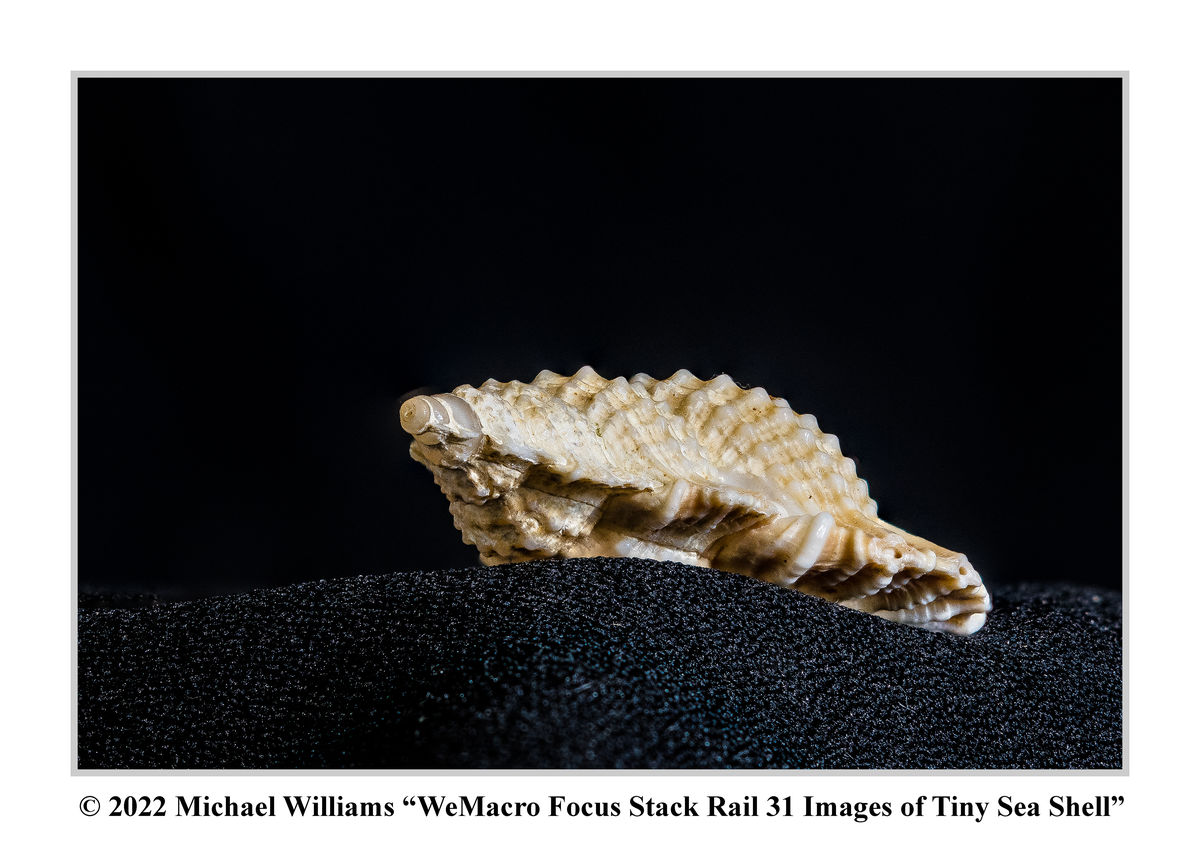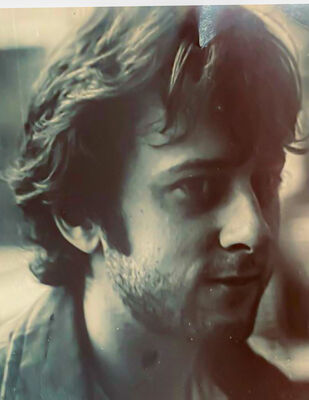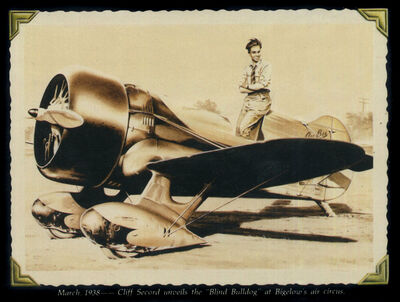My First Focus Stack Using The WeMacro (Focus Stacking) Rail
Feb 9, 2022 04:53:48 #
First attempt at using my new WeMacro (Focus Stacking) Rail. Subject was a tiny 35x26mm Sea Shell. Considering the lens I used, extension tube and the working distance because I could not get the tripod with camera and rail closer to my work table, I should try again with a much larger Sea Shell or better yet a flower. Working distance about 400mm (not totally sure of what use that bit of information is). Photographed ruler to determine actual magnification; crop factor APS-C sensor.
23mm/67mm = 0.34x
Resizing (Cropping) image in Photoshop CS6: 21cm/15cm = 1.4x
PC sized Image before final presentation crop: (0.34)*(1.4) = 0.48x
Presented Size: Unknown!
Pentax K-3 (24MP)
Asahi smc-Pentax-M 100mm f/4 Macro Lens
Pentax Auto Extension Tube #3 (mechanical AE)
Camera set for Manual Focus and Manual Exposure
Exposure ISO 400, f/8, 1/20 second
Lighting Single 5000K LED bulb, white foam core reflector opposite
WeMacro Rail Program
Stacked in distance mode:
Shutter waiting time 1 s
Shutters per step 2
Interval of shutters 1 s
Backlash 180 um
Run Mode by Distance
After done Return
Step length 1mm(fast)
Total distance 30000um
Total steps 30 steps
Total time 120 s
Wow, this process with setting up burns through my camera’s Li-Ion Battery like crazy. I should think of getting an A/C adapter for the camera!
I will need to think of a better shooting set up to get higher magnifications using more tubes and even a bellow. I kept it simple this first try. I’ll need more help and more study to try the Start to End Mode. I did look at the Zerene Stacker Site information and for this shot I did I gleaned for my 0.34x magnification at f/8 for an APS-C sensor a DoF of 2.1mm. So my guess of 1mm DoF should have given plenty of overlap. Any suggestions. Thank you for looking and reading this far. - Mike

23mm/67mm = 0.34x
Resizing (Cropping) image in Photoshop CS6: 21cm/15cm = 1.4x
PC sized Image before final presentation crop: (0.34)*(1.4) = 0.48x
Presented Size: Unknown!
Pentax K-3 (24MP)
Asahi smc-Pentax-M 100mm f/4 Macro Lens
Pentax Auto Extension Tube #3 (mechanical AE)
Camera set for Manual Focus and Manual Exposure
Exposure ISO 400, f/8, 1/20 second
Lighting Single 5000K LED bulb, white foam core reflector opposite
WeMacro Rail Program
Stacked in distance mode:
Shutter waiting time 1 s
Shutters per step 2
Interval of shutters 1 s
Backlash 180 um
Run Mode by Distance
After done Return
Step length 1mm(fast)
Total distance 30000um
Total steps 30 steps
Total time 120 s
Wow, this process with setting up burns through my camera’s Li-Ion Battery like crazy. I should think of getting an A/C adapter for the camera!
I will need to think of a better shooting set up to get higher magnifications using more tubes and even a bellow. I kept it simple this first try. I’ll need more help and more study to try the Start to End Mode. I did look at the Zerene Stacker Site information and for this shot I did I gleaned for my 0.34x magnification at f/8 for an APS-C sensor a DoF of 2.1mm. So my guess of 1mm DoF should have given plenty of overlap. Any suggestions. Thank you for looking and reading this far. - Mike

Feb 9, 2022 05:35:01 #
Very nicely done, Mike. The effort was certainly worth it.
--Bob
--Bob
lamiaceae wrote:
First attempt at using my new WeMacro (Focus Stack... (show quote)
Feb 9, 2022 06:10:49 #
Very nice!! I like the choice of background, it does a great job of highlighting the subject. Sort of like a jeweler putting the diamond ring on black velvet.
Feb 9, 2022 06:28:19 #
…amazing…to think that some critter constructed that from dissolved calcium and bicarbonate…and their imagination…? Nice work…!
Feb 9, 2022 07:54:26 #
Feb 9, 2022 08:57:17 #
SkyKing wrote:
…amazing…to think that some critter constructed that from dissolved calcium and bicarbonate…and their imagination…? Nice work…!
Yes, it does seem miraculous. Another of my hobbies is collecting Sea Shells. I have some that are over 16 inches and in a multitude of shapes. The mollusks seem to know mathematics in the complexities of their shells. I'm going to soon try another larger shell.
Feb 9, 2022 08:58:50 #
rmalarz wrote:
Very nicely done, Mike. The effort was certainly worth it.
--Bob
--Bob
Thank you. This should soon be easier than a good manual stack.
Feb 9, 2022 09:11:55 #
JimmyTB wrote:
Very nice!! I like the choice of background, it does a great job of highlighting the subject. Sort of like a jeweler putting the diamond ring on black velvet.
Thank you for looking and commenting. Yes I like the black background for shells and flowers shot indoors. Ideally for me I can keep the black cloth or black board far out of focus and light that the subject is just floating in black. But here the cloth showed. I have many cloth pieces of a couple square yards to use in different colors and weave patterns. One is dark blue velveteen. Had not found black velvet cheap enough yet. Other times I have shot on back-lite translucent plastic and front lighted subject. Gives a different look.

Feb 9, 2022 10:36:31 #
Feb 9, 2022 18:49:21 #
Feb 10, 2022 09:16:26 #
Very good! I will guess this is a PMax stack if its done with Zerene Stacker. Pixel peeping shows a grain pattern that is like that. Try both DMap and PMax, and see if you can get a good stack mainly with DMap, touched up later around halo areas with the PMax stack. ISO 400 might be adding noise too, but avoiding vibrations with longer exposures could then be an issue of course.
I have only recently discovered how much easier it is doing a table top stack without a tripod. A big tripod standing on the floor, clamped to the edge of a table, makes it so much more awkward to set up and dangerous to work around. Took me long enough to just put the @%$%@ camera on the table!
You mentioned how quickly a stacking run burns thru the camera battery. Are you viewing the camera output during the stacking run on a tethered PC? When I try that I get the same effect. The computer is also working super hard.
I have only recently discovered how much easier it is doing a table top stack without a tripod. A big tripod standing on the floor, clamped to the edge of a table, makes it so much more awkward to set up and dangerous to work around. Took me long enough to just put the @%$%@ camera on the table!
You mentioned how quickly a stacking run burns thru the camera battery. Are you viewing the camera output during the stacking run on a tethered PC? When I try that I get the same effect. The computer is also working super hard.
Feb 10, 2022 09:56:13 #
Mark Sturtevant wrote:
Very good! I will guess this is a PMax stack if it... (show quote)
Wow, thanks for looking Mark. You are way farther in to this than I am. Some of what you wrote I did not understand. Though you seem to have skipped through some of the points I did state. I used the software stacking program that comes standard with the WeMacro Rail. I only mentioned that I looked at some theoretical data and tables of information from the Zerene Stacker Web Site. I actually just stacked my images with Photoshop CS6. Yes, I am still using a purchased DVD-ROM version of Ps, the very last iteration from 2012. Now your comment about ISO I will heed. I had been shooting my Pentax cameras at their factory default of ISO 200. I found for at least this first stack I did the shutter speed was probably fine at 1/20 second. So I can probably take the camera down to ISO 100. It is all good and I'll comment more later and read more suggestions before trying another shoot.

Oh, what I did not understand was "Try both DMap and PMax." I guess these are Zerene things; different algorithms? I did notice the halo and a few remnants. This being more a test of the rail and stacking, I did not want to spend too much time editing or cleaning it up with Photoshop. Though it might be a good one to try as a learning practice. Thanks again.
Feb 10, 2022 11:44:12 #
Mike, you are off to a great start and I'm excited to see more.
I found using the WeMacro in "Start to End" mode worked better for me than distance for I knew where I wanted to start and where I wanted it to end.
Also...I bought AC power supplies for all my cameras. I chose the cheapest ones and they work FANTASTIC for focus stacking sessions. It's also one of the reasons that I went with constant LED illumination for after a few sessions with flashes was enough for me to conclude that batteries, and even rechargeable ones, were not the way to go. I used my studio strobe and burned it up from over heating so I learned a lesson about using them too.
I found using the WeMacro in "Start to End" mode worked better for me than distance for I knew where I wanted to start and where I wanted it to end.
Also...I bought AC power supplies for all my cameras. I chose the cheapest ones and they work FANTASTIC for focus stacking sessions. It's also one of the reasons that I went with constant LED illumination for after a few sessions with flashes was enough for me to conclude that batteries, and even rechargeable ones, were not the way to go. I used my studio strobe and burned it up from over heating so I learned a lesson about using them too.
Feb 10, 2022 12:19:45 #
Mark is spot on..! When choosing to shoot with magnification, every issue that occurs is also magnified. 2X magnification is like having two wives. Higher magnification is like that only more so!!
It is best to shoot at the camera's native ISO. In my case, that's 200. With the camera mounted on rock-solid sub-straight and using constant illumination, long exposures pose no issues. Many of my sessions are two-second shutter speed.
I remind myself that ISO is a function of the camera's microprocessor. The camera sensor is an 'analog' device receiving the rays of reflected light on its photosites that creates an analog signal. There is an "analog to digital converter" that takes that signal and converts it to digital. That signal is then either amplified or retarded by the microprocessor which we identify as the ISO and the exposure compensation settings are either manually set or automatically set.
My first arrangement was a piece of 1/2-inch plywood that was 12-inches wide by 30-inches long. I mounted the WeMacro rail to it 12-inches from one end. I placed it on the countertop and set weights on both ends of the board to subdue as much vibration as possible. It also made it hand because I could pick the entire tabletop macro rig up and move it when needed all as one piece.
The first few sessions that I tried were with a tripod which weight hanging from it and that was far from convenient for I was unable to control vibrations from a living household, street traffic, worst of all, me touching anything anywhere.
SO...I moved it to the basement and I have an old laboratory cabinet with a one-inch thick acid-proof top. I bought a granite kitchen sink cutout from a counter shop as scrap and I placed it on top of that cabinet with high-density vibration isolation pads under it. The platform base that I use now to hold the camera rail also has vibration pad feet so I am confident that I have reduced vibration to a great degree. My sessions are also "hands-free" now.
It is best to shoot at the camera's native ISO. In my case, that's 200. With the camera mounted on rock-solid sub-straight and using constant illumination, long exposures pose no issues. Many of my sessions are two-second shutter speed.
I remind myself that ISO is a function of the camera's microprocessor. The camera sensor is an 'analog' device receiving the rays of reflected light on its photosites that creates an analog signal. There is an "analog to digital converter" that takes that signal and converts it to digital. That signal is then either amplified or retarded by the microprocessor which we identify as the ISO and the exposure compensation settings are either manually set or automatically set.
My first arrangement was a piece of 1/2-inch plywood that was 12-inches wide by 30-inches long. I mounted the WeMacro rail to it 12-inches from one end. I placed it on the countertop and set weights on both ends of the board to subdue as much vibration as possible. It also made it hand because I could pick the entire tabletop macro rig up and move it when needed all as one piece.
The first few sessions that I tried were with a tripod which weight hanging from it and that was far from convenient for I was unable to control vibrations from a living household, street traffic, worst of all, me touching anything anywhere.
SO...I moved it to the basement and I have an old laboratory cabinet with a one-inch thick acid-proof top. I bought a granite kitchen sink cutout from a counter shop as scrap and I placed it on top of that cabinet with high-density vibration isolation pads under it. The platform base that I use now to hold the camera rail also has vibration pad feet so I am confident that I have reduced vibration to a great degree. My sessions are also "hands-free" now.
Feb 10, 2022 16:01:25 #
I was using Zerene Stacker jargon. In dedicated stacking programs (Zerene and Helicon) there are different stacking algorithms. One is good at recording color tones and generates less noise, but it gives the worst in artifacts like halo effects. The other is the opposite for both. They are called DMap and PMax for Zerene. I think Helicon has 3 algorithms, with one being sort of in between the other two (?). Anyway, a common thing is to build the stack in the different algorithms, then use the low noise one as a starting point. Bits of the high noise picture are painted into the low noise picture in places needed to resolve halo and transparency artifacts. Original pictures used to make the stacks can also be painted in here and there to resolve problems that the hi noise stack can't fix, but that can be quite a chore if there are a lot of pictures, so each thing to fix needs several pictures.
I know next to nothing about the Helicon Focus stacking program, but Zerene Stacker is at least as good, and the online tutorials they provide are a thing of beauty and clarity to watch. I sort of know the person who made those tutorials, and he is just amazingly clear in how he explains things.
I will be way behind the curve where you and Sippy are concerned since I am more into informal stacking that can be done on a bouncy wood floor at our dining room table, with somebody walking by pretty frequently. Sippy would cringe at my environment! 🙂
I know next to nothing about the Helicon Focus stacking program, but Zerene Stacker is at least as good, and the online tutorials they provide are a thing of beauty and clarity to watch. I sort of know the person who made those tutorials, and he is just amazingly clear in how he explains things.
I will be way behind the curve where you and Sippy are concerned since I am more into informal stacking that can be done on a bouncy wood floor at our dining room table, with somebody walking by pretty frequently. Sippy would cringe at my environment! 🙂
If you want to reply, then register here. Registration is free and your account is created instantly, so you can post right away.








